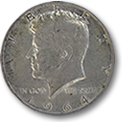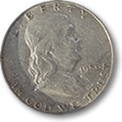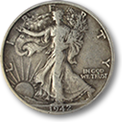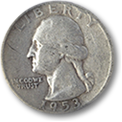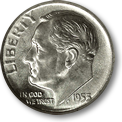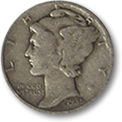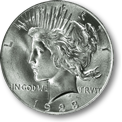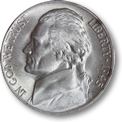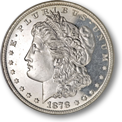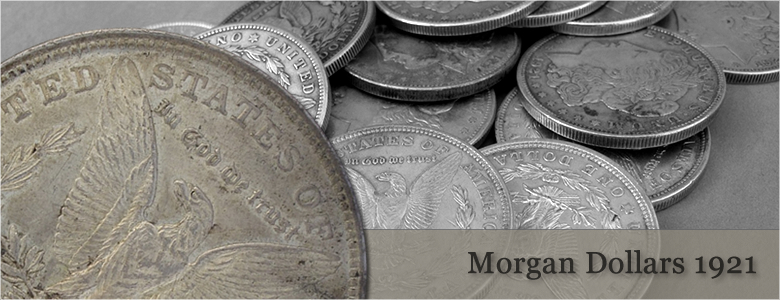
The 1921 Silver Morgan Dollar
The 1921 Silver Morgan Dollar gained its fame by being struck under unusual conditions.This was the first standard silver dollar that was minted since its denomination stopped because of the passing of the Fourth Coinage Act. This Act also ended the free coining of silver. It was named for its designer, assistant engraver to the US Mint Department, George T. Morgan. On its obverse is a profile of Lady Liberty. On its reverse stands an eagle with outstretched wings.
At the time, the coinage laws required the maintenance of specific numbers of the various coins in circulation in order to uphold the balance and serve the need for coinage currency during those years. It was actually supposed to be the year of the silver Peace Dollar, which was still in the process of being designed and struck. The silver Peace Dollar, however, was not ready by the time the public needed the $1 coin released into circulation if the numbers of needed currency were to be met. Silver coin shortages could be dangerous for the growing US economy.
There were nearly 86 million new silver Morgan Dollars struck that year which made the date common at the time. They were struck in Denver because all other Mint Departments had suspended the die in 1904, as ordered. The Denver Mint was opened in 1906, after an ordered suspension of other Mint Department silver dollar coin strikes. This meant that no legal mandate prevented this particular Mint Department from striking the Morgan Dollar. The law reflecting authorization for the change in its design is reflected through what was known as the 1880 Act of Congress and it read as follows:
"But no change in the design or die of any coin shall be made oftener than once in twenty-five years from and including the year of the first adoption of the design, model, die, or hub for the same coin: Provided, That no change be made in the diameter of any coin: And provided further, That nothing in this section shall prevent the adoption of new designs or models for devices or emblems already authorized for the standard silver dollar and the five-cent nickel piece as soon as practicable after the passage of this act."
Another provision called "The Pittman Act" served to authorize coinage for replacement for every silver dollar that the act had ordered to be melted. Since all obsolete coinage dies had been destroyed in 1910, the designer, George Morgan, was forced to create an entirely new master die for the junk silver dollar.
Morgan silver dollars are extremely popular and sought after world-wide. They are classic silver coinage that impressed the public by how magnificently detailed and how cleanly the design worked when struck, while holding intrinsic patriotic feelings within the design. They also were made from 90% silver, giving them intrinsic silver bullion value for the junk silver grade coins.
Designing of coins had become a distinctly American process, even to the point of holding contests across the nation to discover America's finest sculptors and medalists. An award of a thousand dollars was the common prize and worked to generate coinage that would show the world how unique, skilled and talented our newly independent national culture had become. These classic silver dollars had literally become the backbone of daily commerce both nationally and internationally and served in this capacity for decades. They are highly sought for their silver content: 90 percent silver and ten percent copper. They are also appreciated for their excellence in minting and the leverage they give into the silver market.
The Morgan had been minted first in 1878, continuing into 1904. It was produced only one more time during 1921. By 1904 the national silver bullion supplies had become depleted. This problem caused the government to suspend silver dollars all together. Under the Pittman Act of 1918, over 270 million silver dollars were melted down for their bullion. The American economy was booming after World War I. The need for more junk silver dollars in the currency became acute. Some refinements were made in order to allow the resurrected production for less than a full year. This was essentially the place-holder that was to usher-in the new silver Peace Dollar that the public felt a deep need for. The relief America was feeling to be free from the vestiges of a warring nation and the fact that the war itself had been billed as the "War to End all Wars" had caused the people of this nation to spill into the streets in a remarkable show of dancing and celebrating on Armistice Day.
It is for these reasons the silver 1921 Morgan Dollar became a one-year type-coin unto itself. In spite of the high mintage numbers, few 1921 Morgans survive today in BU or Brilliant Uncirculated mint condition. This is due to their intense popularity during the "roaring 20's" when they were used lavishly and heavily as spending money. The presence of the 1921 BU Morgan is actually less common than finding the BU Peace Dollar, although today they are traded for roughly the same price. These coins remain a great long-term investment value today. Some feel they strongly exceed their junk silver bullion value because of the exquisite and inherent beauty of this specific coin design. This is supported by the fact that many expert collectors obtain these coins as their investment in junk silver bullion coins.
The first version of the 1921 Morgan is known as the "Zerbe" Proof which was struck for numismatic scholar Farran Zerbe, who according to histories actually threw a fit when he was told the silver Peace Dollar would not be ready on time. He was the primary promoter of the Peace Dollar design that was to come into circulation later that year.
Two unusual proof examples of this date were commissioned to be struck by people who were not working for the US Treasury Mint Department. Zerbe was one of these two. The exact number of this first proof mintage are unclear, however the numbers in conversation through the years tally around lows of 20 to highs of 200. The very first and finest un-circulated examples graded by PCGS (Professional Coin Grading Service) are 6 MS-67s, a single MS-67 "Proof-like" and 5 MS-64 "Deep Mirror Proof-likes." PCGS also certified 78 "Zerbe" Proofs he had seen and had cleaned, or scrubbed however this account seems to conflict with findings of the PCGS that prevents certification for cleaned or impaired coins. The very finest of the Zerbe Proofs were 7 PR-66s. There continue to be barely detectable die file marks, unusually sharp feathers and faintly visible re-cuttings from some proofs that evidently were carelessly made.
The second Proof version came to be called the "Chapman" Proof due to the involvement of a Philadelphia coin dealer named Henry Chapman. His name appears on a Mint invoice dated June 11, 1921 which authorizes the sale of "10 proof silver dollars 1921." Years went by while collectors believed this mintage was limited to those ten coins, however later it was discovered additional "Chapman Proofs" had been struck. PCGS certified 40 examples that include a single PR-66 that called enormous attention to its quality over the 13 PR-64s that came into the next level below it. There was only one Proof Cameo example graded by PCGS, a single PRCA-64. The "Chapman Proofs" are considered super-brilliant, having only 16 berries in the wreath on the reverse as opposed to 17 on the "Zerbe" Proofs. Other die cast characteristics include the hollow area around Morgan's initial on its truncation line on the obverse that was caused by die polishing. There are also die striations around the UN, AM and RICA on its reverse.
The coin is not considered rare, and the Numismedia reports show retail values from $14 to about $17 as of 2009. (Today, in 2011, the price is double that for any junk silver dollar due to the intrinsic 90% silver content.) It has a higher value if it is only lightly or un-circulated. The value goes up if it is missing its mint-mark. Check for the mint-mark letter above the DO in the word "dollar" on the back. There would be either an S or a D to identify which Mint Department struck the coin.
With no mint-mark at all the coin's value runs around $24 to $1000 (in 2009) depending on its quality. The "D" mint-mark coins go for $38 to $1300. The "S" starts at $34 and soars to $9000. The coin had 44,690,000 circulation strikes. There were 250 proofs sets made. Its PCGS numbers include 7296, 7297, 9729, 7342. The coin is 38.1 millimeters in diameter, and weighs 26.73 grams. The coin has reeded edges, no mint-mark if struck in Philadelphia, otherwise the mark shows up on its reverse below the center of the wreath.
To collectors this coin is better than junk silver bullion coins or silver bullion bars. This is due to not only its scarcity but also for its numismatic value. It can be found at low costs even though it remains harder to find than the Peace Dollar. This level of scarcity adds to its leverage when prices of silver begin to rise. It is not like other bullion coins since it is exempt from broker reporting and government confiscation due to the status as a scarce and collectible item. They are also admired for the instant worldwide liquidity that they offer.
It is interesting to note how much of our nation's history is learned when becoming proficient at coin collecting. It is an amazing hobby to teach to children and young adults who are learning about economics, currency, and mathematical values. One way to engage a wonderful family project is to take up the coin collection hobby as an entire family, as this also greatly increases your chances of running across valuables that run loose in common change.
When recognizing how much power is wielded by those who discover ways to influence the production of coins, we can also find value in learning more about the US Treasury Mint Department, and the locations nearest you. This would be a place where coming in contact with production specialists can also give any individual an enormous amount of information about how to identify and ascertain blemishes, errors, strike-overs and double dates first-hand. The more knowledgeable one becomes as a collector, the more easily value can be added to any collection series.








